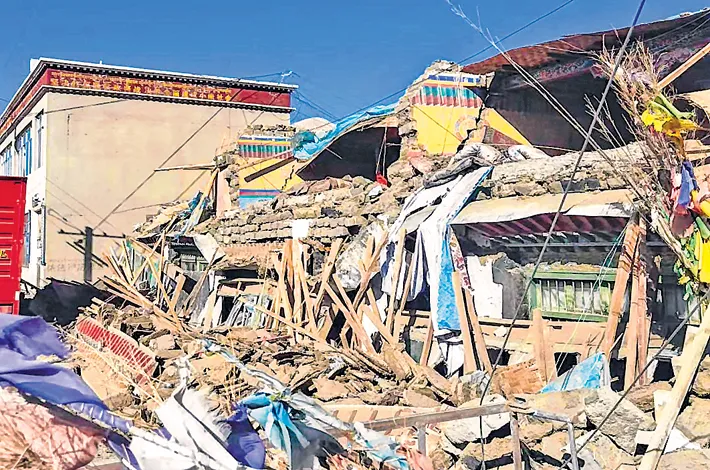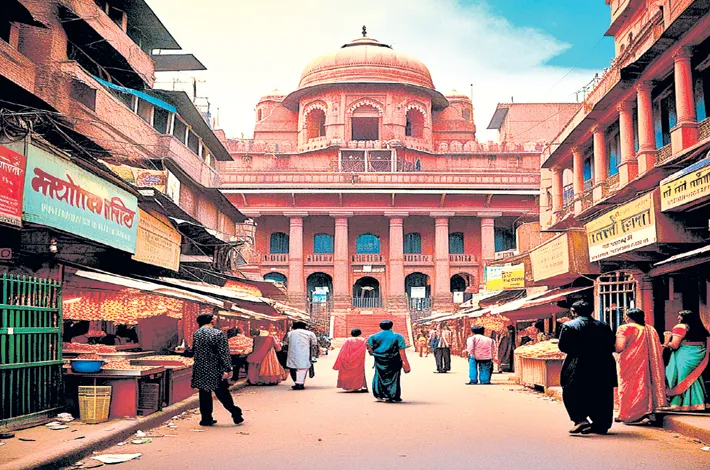Tibet quake: Cold enemy of survivors
09-01-2025 12:00:00 AM

Rescuers scramble | Experts say those trapped under rubble or shelterless for over 24 hrs will die of hypothermia in five to 10 hours even if uninjured as temperature drops to 18 degrees Celsius
Agencies BEIJING
Twenty-four hours after the temblor struck, rescuers were looking for survivors in an area roughly the size of Cambodia as those trapped under rubble would have endured a night in sub-zero temperatures. So far more than 400 people have been rescued, Chinese officials said on Wednesday. However, an unknown number is still unaccounted for in freezing weather.
The epicentre of Tuesday's magnitude 6.8 quake, one of the region's most powerful tremors in recent years, was located in Tingri, about 80 km north of Mount Everest, the world's highest mountain. It also shook buildings in neighbouring Nepal, Bhutan and India.
Temperatures in the high-altitude region dropped as low as minus 18 degrees Celsius (0 degrees Fahrenheit) overnight. People trapped or those without shelter are at risk of rapid hypothermia and may only be able to live for five to 10 hours even if uninjured, experts say.
Footage broadcast on state television CCTV showed families huddled in rows of blue and green tents quickly erected by soldiers and aid workers in settlements surrounding the epicentre, where hundreds of aftershocks have been recorded.
At least 126 people were known to have been killed and 188 injured on the Tibetan side, state broadcaster CCTV reported. No deaths have been reported in Nepal or elsewhere.
The quake was so strong that part of the terrain around the epicentre slipped as much as 1.6 metres over a distance of 80 km, according to an analysis by the.
Chinese authorities have yet to announce how many people are still missing. In Nepal, an official told Reuters the quake destroyed a school building in a village near Mount Everest, which straddles the Nepali-Tibetan border. No one was inside at the time.
Lone German climber Jost Kobusch said he was just above the Everest base camp on the Nepali side when the quake struck. His tent shook violently and he saw several avalanches crash down. He was unscathed.
"I'm climbing Everest in the winter by myself and...looks like basically I'm the only mountaineer there, in the base camp there's nobody," Kobusch told Reuters in a video call.
No avalanches have been observed on Everest so far, state-run Xinhua news agency reported on Wednesday, citing Chinese scientists.
But damage around the epicentre was extensive.
An initial survey showed 3,609 homes had been destroyed in the Shigatse region, home to 800,000 people, state media reported late on Tuesday. More than 14,000 rescue personnel had been deployed.
More than 46,500 people affected by the quake have been relocated, and 484 tourists in Tingri have been safely transported to the city of Shigatse, local officials said at a press conference on Wednesday.
Home to some 60,000 people, Tingri is Tibet's most populous county on China's border with Nepal and is administered from Shigatse, the traditional seat of the Panchen Lama, one of the most important figures in Tibetan Buddhism.
No damage has been reported to Shigatse's Tashilhunpo monastery, state media reported. It was founded in 1447 by the first Dalai Lama.
Southwestern parts of China, Nepal and northern India are often hit by earthquakes caused by the collision of the Indian and Eurasian tectonic plates, which are pushing up an ancient sea that is now the Qinghai-Tibetan plateau.
As of noon on Wednesday, 646 aftershocks with magnitudes of up to 4.4 continued to jolt the area around the epicentre.








